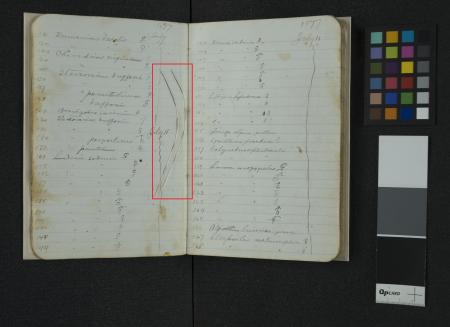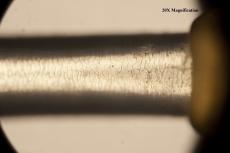
There they were, tucked between the pages of a catalog of Alaskan bird skins, and eggs by Edward William Nelson , but . . . what were they? They certainly didn’t look like they belonged to a bird. About five inches long, wavy and coarse, with brown and white banding, the mystery hairs presented themselves as a question and an opportunity. Being a pre-program conservation intern at the Smithsonian Institution Archives on the Field Book Project has been such a pleasure and the path to discovering the answer to this hairy problem is exactly the kind of thing I love about working with cultural heritage items.
Just looking at the hairs with an unaided eye, my first guess was that they were the guard hairs of a porcupine. The first step to find out if I was right was to head to the microscope. Working first with a stereo microscope and then with a polarized light microscope, I set to work learning more about the hairs. The animated GIF below illustrates how polarized light microscopy works (click on the picture below to see it). As the microscope stage is turned, the hairs change appearance. When viewed through a transmitted light analyzer (a type of filter,) the polarized light allows us to observe different features based on how light is refracted or transmitted through structures differently. The first image in the GIF is the hair under unfiltered polarized light. 
The microscopy yielded lots of important information, for instance you can see the striations and the empty space known as the medulla, rather than a central shaft. Along with the scale pattern, this verified that these were not feathers. The particular scale and medulla patterns seen above, when compared to a known example indicated that it wasn’t quite a porcupine. On to the next guess. A deer, perhaps? Nope! The unique ribs on the hairs meant it probably couldn’t be a deer, despite a lot of similarities. What other animals were there in Alaska that might have this type of hair structure?

 I was officially stumped, so I turned to the experts. Luckily, being an intern with the Smithsonian has its perks and the experts were right across the National Mall at the National Museum of Natural History. I met with Suzanne Peurach, a Collection Manager on the U. S. Geological Survey staff (a descendent of the same organization Edward William Nelson worked for), in the Division of Mammals. In no time, she and her colleague, Al Gardner, deduced that it was not in fact a deer hair, nor was it that of a porcupine. It turns out I had been looking at animals in the wrong part of the world. Edward William Nelson didn’t just spend time in Alaska, though the book I was working with detailed an Alaskan collection. For nearly a decade, Nelson was a field researcher in Mexico. It was here that he would have picked up the two hairs which had spent so much time puzzling me, not in the cold of Alaska. The hairs turned out to be those of a javelina, a.k.a. collared peccary! Using existing slides to compare, Suzanne found the same ribs that I couldn’t find in any other specimen I had looked at. Furthermore, she pointed to a clue I had not even seen (that’s why she’s the expert). The split ends of the hair, which I had not thought of as special, were the key indicator that it belonged to a member of the family Tayassuidae, which includes the javelina.
I was officially stumped, so I turned to the experts. Luckily, being an intern with the Smithsonian has its perks and the experts were right across the National Mall at the National Museum of Natural History. I met with Suzanne Peurach, a Collection Manager on the U. S. Geological Survey staff (a descendent of the same organization Edward William Nelson worked for), in the Division of Mammals. In no time, she and her colleague, Al Gardner, deduced that it was not in fact a deer hair, nor was it that of a porcupine. It turns out I had been looking at animals in the wrong part of the world. Edward William Nelson didn’t just spend time in Alaska, though the book I was working with detailed an Alaskan collection. For nearly a decade, Nelson was a field researcher in Mexico. It was here that he would have picked up the two hairs which had spent so much time puzzling me, not in the cold of Alaska. The hairs turned out to be those of a javelina, a.k.a. collared peccary! Using existing slides to compare, Suzanne found the same ribs that I couldn’t find in any other specimen I had looked at. Furthermore, she pointed to a clue I had not even seen (that’s why she’s the expert). The split ends of the hair, which I had not thought of as special, were the key indicator that it belonged to a member of the family Tayassuidae, which includes the javelina.

As I said, being a conservation intern at the Smithsonian Archives has been a wonderful experience, and the best part of it by far is the opportunity to meet and work with the people who make up the staff and volunteer corps of the Smithsonian. Microscopy had given me a lot of clues, but it was the access to and the spirit of collaboration among experts at the Smithsonian that ultimately guided me to the answer of the mystery hairs.
Related Collections
- Record Unit 7364 - Edward William Nelson and Edward Alphonso Goldman Collection, circa 1873-1946 and undated, Smithsonian Institution Archives
- Accession 12-320 - Edward William Nelson Field Notes, 1869-1886, Smithsonian Institution Archives
Produced by the Smithsonian Institution Archives. For copyright questions, please see the Terms of Use.

Leave a Comment